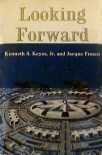Looking Forward, Kenneth Jr. [best android ereader txt] 📗

- Author: Kenneth Jr.
Book online «Looking Forward, Kenneth Jr. [best android ereader txt] 📗». Author Kenneth Jr.
“If anyone doubts who is in supreme command in this man-machine complex, let him consider this: the master power switch that could inactivate Corcen is on the wall over there. We would also have to shut down the emergency duplicate of Corcen that is maintained in Europe. If these switches were thrown without planning, it would result in utter chaos. With careful planning it would be possible to inactivate Corcen and fragment the world once again. We could chop up the world into as many pieces as we wanted and operate each one independently. Confusion and a return to the primitive society of our ancestors would be the unhappy result. If we asked Corcen to plan its own elimination for us, it would probably be done in a way that would minimize the disadvantages. But it would be like killing what makes us truly human, truly free, truly happy.”
“How completely we trust ourselves and each other,” thinks Hella, looking at the master switch that activates Corcen. “No one will ever touch it, but it’s nice to know it’s there.”
Ultimate Predictability
The teleprojected figure walks to a large table. The group follows him. A loudspeaker above the table begins, “The fundamental principle upon which Corcen operates is that decisions with a high degree of predictability can be made when adequate facts are available. We would like to give you a demonstration of this. Before you is a table twenty-four feet in diameter. Above the table you will see a small container that has fifty steel balls that are exactly twelve millimeters in diameter. These balls will now be mixed.”
The transparent container holding the fifty balls turns upside down so that all balls jostled around to a new position.
“You will notice that there are electronic sensors in twelve positions surrounding these balls,” the loudspeaker continues. “These sensors in a millionth of a second have already determined the location of each of these balls. This data will now be fed into Corcen (here Hella looks up at the six-foot sphere, only fifty feet away, and less than a second later Corcen will predict the eventual landing place of each of these balls when dropped onto the table three feet below.”
The group looks at the table and notices that there are a number of white dots that have appeared on the dark surface. The speaker continues to describe what everyone has now guessed. “When these balls are dropped, they will tumble against each other; they will hit the table; they will bounce. Some of them will hit other balls while rolling, but within a few seconds all of these balls will stop rolling. They will come to rest exactly on the fifty white dots. Let us see if Corcen has accurately predicted their behavior.”
The transparent container releases its flood of fifty balls. There is a series of metallic clanks as these fifty steel spheres bounce around in apparently random fashion. But within twelve seconds all but one come to rest. One seemingly erratic ball has bounced against the edge of the table. It hits a stopped ball that rolls to cover a white dot and, in so doing, deflects its own movement until, at last, the only dot remaining is covered. Hella takes a deep breath. Fantastic predictability!
The speaker continues. “If we provided our best mathematician with pencil and paper, it would have taken him over ten years to make the computations with the same degree of accuracy that Corcen produced in less than a second!
“This is the guiding principle of our Correlation Center: although we know it is impossible to predict the behavior of single atoms, the prediction of the average behavior of an aggregate of atoms—which we regard as objects in the real world—is predictable within stated limits of reliability if we have an adequate sampling of facts. Note that we do not have to know all of the facts—this is impossible. An adequate sampling of relevant facts does the job for us.”
The speaker above the table stops. The teleprojected guide again takes over. “Several centuries ago the affairs of mankind were far simpler.” A large screen lights up. It shows a map of the world with population figures superimposed on each country. “Up until the eighteenth century most European nations had less than 25 million people. Great Britain never exceeded ten million people. The interaction of government with economic and social affairs was relatively simple. Most intelligent citizens who wished to be informed of the issues could have made fairly useful predictions. If predictions were inaccurate, the stakes were not high, and things tended to move slowly. They could have been corrected by the succeeding generation without too much harm to mankind.
“The situation changed radically in the twentieth century. Prior to that time a war might have killed a half-million people. The first major war of the twentieth century killed ten million people. The second major war killed five times as many. Had a third major war taken place, it is likely that billions of people would have been killed, to say nothing of the devastated cities and industrial plants. An ulcer in the stomach of a dictator could have played a part in a hasty emotional reaction that could have caused this catastrophe. Capricious, ineffective government by individuals could no longer have been tolerated. During most of the twentieth century, a mixture of democratic and totalitarian governments controlled the lives and destinies of over 100 petty, touchy, nationalistic units. No





Comments (0)